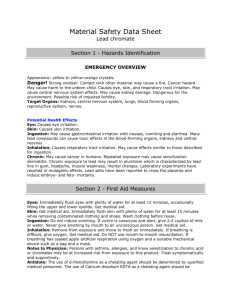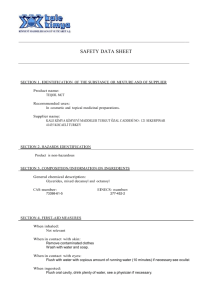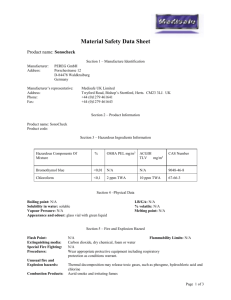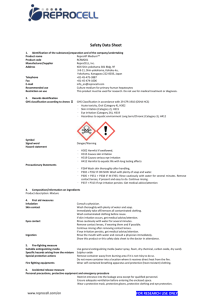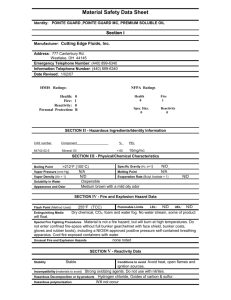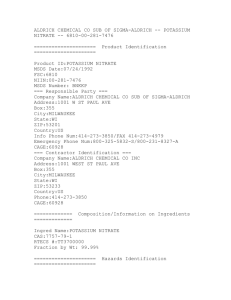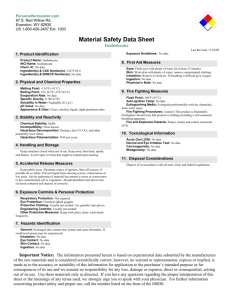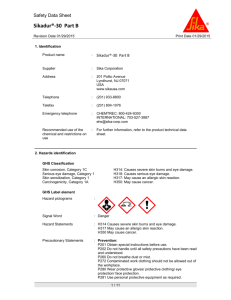Safety Data Sheet
advertisement
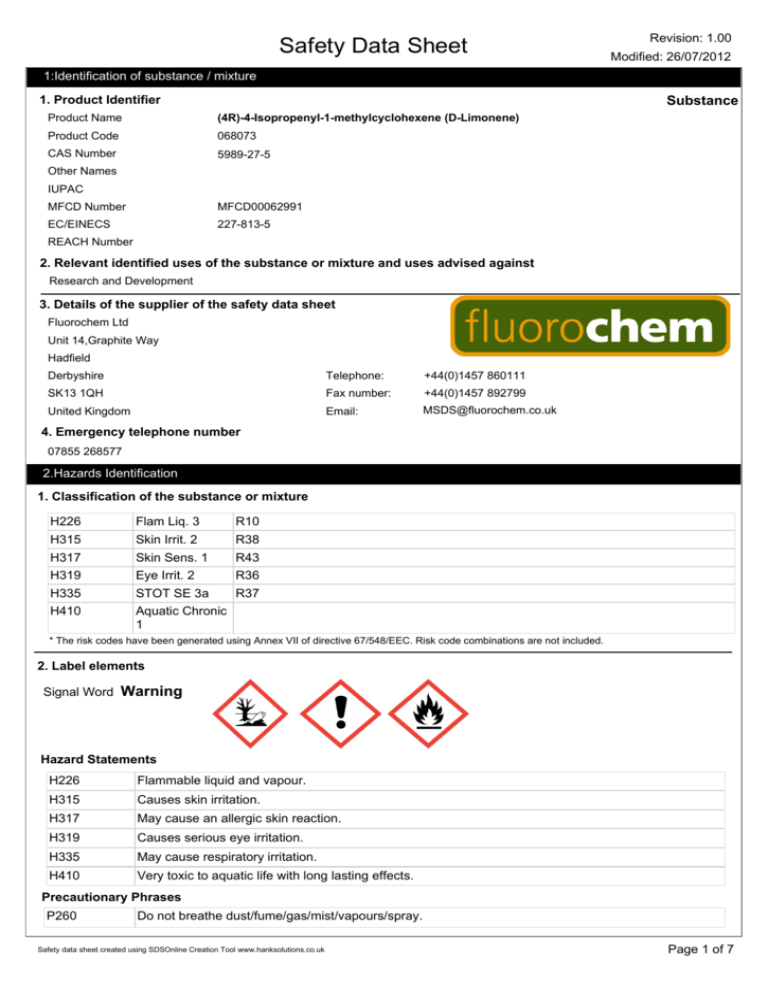
Safety Data Sheet Revision: 1.00 Modified: 26/07/2012 1:Identification of substance / mixture 1. Product Identifier Substance Product Name (4R)-4-Isopropenyl-1-methylcyclohexene (D-Limonene) Product Code 068073 CAS Number 5989-27-5 Other Names IUPAC MFCD Number MFCD00062991 EC/EINECS 227-813-5 REACH Number 2. Relevant identified uses of the substance or mixture and uses advised against Research and Development 3. Details of the supplier of the safety data sheet Fluorochem Ltd Unit 14,Graphite Way Hadfield Derbyshire Telephone: +44(0)1457 860111 SK13 1QH Fax number: +44(0)1457 892799 United Kingdom Email: MSDS@fluorochem.co.uk 4. Emergency telephone number 07855 268577 2.Hazards Identification 1. Classification of the substance or mixture H226 Flam Liq. 3 R10 H315 Skin Irrit. 2 R38 H317 Skin Sens. 1 R43 H319 Eye Irrit. 2 R36 H335 STOT SE 3a R37 H410 Aquatic Chronic 1 * The risk codes have been generated using Annex VII of directive 67/548/EEC. Risk code combinations are not included. 2. Label elements Signal Word Warning Hazard Statements H226 Flammable liquid and vapour. H315 Causes skin irritation. H317 May cause an allergic skin reaction. H319 Causes serious eye irritation. H335 May cause respiratory irritation. H410 Very toxic to aquatic life with long lasting effects. Precautionary Phrases P260 Do not breathe dust/fume/gas/mist/vapours/spray. Safety data sheet created using SDSOnline Creation Tool www.hanksolutions.co.uk Page 1 of 7 Revision: 1.00 Safety Data Sheet Modified: 26/07/2012 P273 Avoid release to the environment. P280 Wear protective gloves/protective clothing/eye protection/face protection. P303 + P361 + P353 IF ON SKIN (or hair): Remove/Take off immediately all contaminated clothing. Rinse skin with water/shower. P304 + P340 IF INHALED: Remove victim to fresh air and keep at rest in a position comfortable for breathing. P305 + P351 + P338 IF IN EYES: Rinse cautiously with water for several minutes. Remove contact lenses, if present and easy to do. Continue rinsing. P370 + P378 In case of fire: Use sand, CO2 or extinguishing powder for extinction. 3. Other Hazards Additional precautionary phrases are located throughout the safety data sheet 3.Composition / Information on Ingredients 1. Substances (4R)-4-Isopropenyl-1-methylcyclohexene (D-Limonene) Assay:100% CAS Number :5989-27-5 2. Mixtures Not Relevant 4.First Aid Measures 1.Description of first aid measures Skin Contact IF ON SKIN (or hair): Remove/Take off immediately all contaminated clothing. Rinse skin with water/shower. If skin irritation occurs: Get medical advice/ attention. Eye Contact If eye irritation persists: Get medical advice/attention. IF IN EYES: Rinse cautiously with water for several minutes. Remove contact lenses, if present and easy to do. Continue rinsing. Ingestion Wash out mouth with water. Inhalation IF INHALED: Remove victim to fresh air and keep at rest in a position comfortable for breathing. 2.Most important symptoms and effects There may be irritation and redness. 3.Indication of any immediate medical attention No additional measures required 5.Firefighting measures 1.Extinguishing Media Suitable In case of fire: Use sand, CO2 or extinguishing powder no data Unsuitable no data 2.Special Hazards arising from the substance or mixture In combustion toxic fumes may form. 3.Advice for Fire Fighters Wear self-contained breathing apparatus. Wear protective clothing to prevent contact with skin and eyes. Safety data sheet created using SDSOnline Creation Tool www.hanksolutions.co.uk Page 2 of 7 Safety Data Sheet Revision: 1.00 Modified: 26/07/2012 6.Accidental Release Measures 1.Personnal Precautions Eliminate all sources of ignition. Do not attempt to take action without suitable protective clothing – see section 8 of SDS. 2.Environmental Precautions Do not discharge into drains or rivers. Contain the spillage using bunding. 3.Methods & Materials Mix with sand or vermiculite. Transfer to a closable, labelled salvage container for disposal by an appropriate method. 7.Handling and Storage 1.Personnal Precautions Safe Handling Ensure there is sufficient ventilation of the area. Avoid release to the environment. Ground/bond container and receiving equipment. Wash handsoughly after handling. Protection against explosions and fires Take off contaminated clothing and wash before reuse. Take precautionary measures against static discharge. Use explosion-proof electrical/ventilating/lighting/. Use only non-sparking tools. 2.Conditions for safe storage, including any incompatibilities Managing Storage Risks Store in cool, well ventilated area. Keep away from sources of ignition. Keep container tightly closed. Keep away from direct sunlight. Storage Controls No special requirements Maintaining Integrity Keep away from heat/sparks/open flames/hot surfaces. – No smoking. Keep container tightly closed. Other advice Store in a well-ventilated place. Keep container tightly closed. 3.Specific End Uses The end use(s) have not been fully determined. The substance is supplied for Research and Development purposes by professionals only. 8.Exposure Controls/Personal Protection 1. Control Parameters No Data Available Safety data sheet created using SDSOnline Creation Tool www.hanksolutions.co.uk Page 3 of 7 Safety Data Sheet Revision: 1.00 Modified: 26/07/2012 2.Exposure Controls General protective and hydgiene measures Wear protective gloves/protective clothing/eye protection/face protection. . Wash hands during breaks and at the end of handling the material Immediately remove any contaminated clothing Engineering measures Use only outdoors or in a well-ventilated area. Eye / Face Protection Safety Glasses with side-shields. Hand protection Protective gloves. Respiratory protection Do not breathe dust/fume/gas/mist/vapours/spray. . Use breathing protection with high concentrations Skin protection Handle with gloves. Dispose of contaminated gloves after use in accordance with applicable laws and good laboratory practice. Wash and dry hands. Protective clothing. Other personal protection advice no data 9.Physical and Chemical Properties 1. Physical and Chemical Properties Appearance Clear colourless liquid Odour Not Applicable Odour threshold Not Applicable PH Not Applicable Melting point / Freezing point Not Applicable Initial boiling point and boiling range 176-177°C Flash point 48°C Evaporation rate Not Applicable Flammability(solid,gas) Not Applicable Upper/lower flammability or explosive limits Not Applicable Vapour pressure Not Applicable Vapour density 4.70 Relative density 0.842 Solubility(ies): Not Applicable Partition coefficient: n-octanol/water Not Applicable Auto-ignition temperature Not Applicable Decomposition temperature Not Applicable Viscosity Not Applicable Explosive properties Not Applicable Oxidising properties Not Applicable 2.Other Information No additional information available 10.Stability and Reactivity 1.Reactivity Safety data sheet created using SDSOnline Creation Tool www.hanksolutions.co.uk Page 4 of 7 Safety Data Sheet Revision: 1.00 Modified: 26/07/2012 no unusual reactivity 2.Stability Stable under normal conditions. 3.Possibility of Hazardous Reactions no hazardous reactions known 4.Conditions to Avoid no specific conditions to avoid 5.Incompatible Materials Oxidising agents. Bases. 6.Hazardous Decomposition Products In combustion emits toxic fumes. 11.Toxicology information 1.Information Acute Toxicity Oral LD50 (Rat) 4,400mg/kg Dermal LD50 (Rabbit) >5,000mg/kg Skin corrosion/irritation irritant for skin and mucous membranes Serious eye Damage/irratation irritant effect Respiratory or skin sensitisation No sensitizing effect known Germ Cell mutagenicity not known Carcinogenicity not known Reproductive toxicity not known STOT-single exposure not known STOT-repeated exposure not known Aspiration hazard not known 2.Additional To the best of our knowledge the acute and chronic toxicity of this substance is not fully known. No classification data on carcinogenic properties of this material is available from the EPA, IARC,NTP,OSHA or ACGIH 12.Ecological Information 1.Toxicity Toxicity to fish: LC50 - Pimephales promelas (fathead minnow) 0,702 mg/l - 96h EC50 - Daphnia pulex (water flea) 69.6mg/l - 48h 2.Persistance and degradability Safety data sheet created using SDSOnline Creation Tool www.hanksolutions.co.uk Page 5 of 7 Safety Data Sheet Revision: 1.00 Modified: 26/07/2012 not known 3.Bio-Accumulative Potential not known 4.Mobility and Soil not known 5.Results of PBT & vPvB assessment not known 6.Other adverse effects Do not allow product to reach ground water, water bodies or sewage system, even in small quantities. Very toxic for aquatic organisms 13.Disposal Considerations 1.Waste Treatment Methods Disposal Operations Disposal of Packaging Disposal must be made according to official regulations. 14. Transport Information Air (ICAO) 1. UN Number: 2052 2. UN proper shipping name: Dipentene 3. Transport hazard class(es): Class: 3 4. Sub Class : Packing group: III 5. Environmental hazards: 6. Special Precautions for user: 7. Transport in bulk: Road (ADR) 1. UN Number: 2052 2. UN proper shipping name: DIPENTENE 3. Transport hazard class(es): Class: 3 4. Sub Class : Packing group: III 5. Environmental hazards: 6. Special Precautions for user: 7. Transport in bulk: Sea (IMDG) 1. UN Number: 2052 Safety data sheet created using SDSOnline Creation Tool www.hanksolutions.co.uk Page 6 of 7 Safety Data Sheet 2. 3. Modified: 26/07/2012 UN proper shipping name: Dipentene Transport hazard class(es): Class: 3 4. Sub Class : Packing group: III 5. 6. Revision: 1.00 Environmental hazards: Marine Pollutent: Y Special Precautions for user: 7. Transport in bulk: IBCINS: IBC03 UNTANKINS: T2 TANKPROV: TP1 15.Safety, health and environmental regulations 1.Safety, health and environmental regulations: product is not subject to any additional regulations or provisions 2. Safety Assessment No Chemical Safety Assessment 16.Other Information 1.Other Information: ADR: Accord Europeen sur le transport des merchandises Dangereuses par Route(European Agreement concerning the International Carriage of Dangerous Goods by road) RID:Reglement International concernant le transport des merchandises dangereuses par chemin de fer (Regulations concerning the International transport of Dangerous Goods by Rail) IMDG: International Maritime Code for Dangerous Goods IATA: International Air Transport Association IATA-DGR: Dangerous Goods Regulations by the International Air Transport Association ICAO:International Civil Aviation Organization ICAO-TI: Technical Instructions by the ICAO GHS: Globally Harmonized System of Classification and Labelling of Chemicals CAS:Chemical Abstracts Service 2. Associated risk phrases according to european directive 67/548/EEC R10 Flammable. R36 Irritating to eyes. R37 Irritating to respiratory system. R38 Irritating to skin. R43 May cause sensitisation by skin contact. 3. Disclaimer The product listed is for research and development purposes only and not for human or animal use. As such, in most cases, the toxicological, ecological and physicochemical properties have not been fully determined and the product should be treated with respect and always handled under suitable conditions by appropriately qualified personnel. The responsible party shall use this datasheet only in conjunction with other sources of information gathered by them, and should make an independent judgement of suitability, to ensure proper use and protect the health and safety of employees. This information is furnished without warranty and any use of the product not in conformance with this material safety data sheet, or in combination with any other product or process, is the responsibility of the user. Safety data sheet created using SDSOnline Creation Tool www.hanksolutions.co.uk Page 7 of 7
